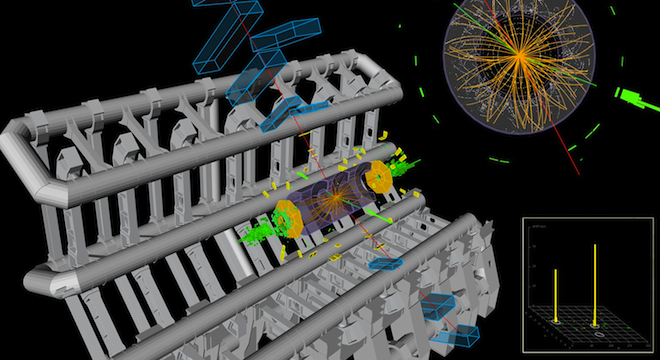Physicists around the world are eagerly awaiting an upcoming July 4 announcement by the European Organization for Nuclear Research (CERN) regarding the status of the agency’s hunt for the missing “God particle,” the Higgs boson, which is the final major piece needed to explain how all matter in the universe has mass.
But CERN’s own chief doesn’t even know whether the agency has found the particle or not, according to one physicist involved in the hunt.
“People are eager to see what will be there of course,” said Pauline Gagnon, a particle physicist at CERN, in an email to TPM. “Nobody knows yet, not even the Director General!”
Gagnon works specifically on CERN’s ATLAS experiment, one of six experiments running on the Large Hadron Collider, the world’s largest and most powerful particle accelerator, a nearly 17-mile-around ring located underground near CERN’s headquarters in Geneva, Switzerland. The accelerator is also managed by CERN.
Gagnon explained that after about 60 days of continuous run-time at its highest-energy level yet, the Large Hardon Collider has been switched off as planned, in an 11-day-long “technical stop” for routine maintenance.
But during its earlier operating time, scientists filled the accelerator with proton beams and accelerated them to nearly the speed of light in opposite directions, smashing them together in collisions designed to simulate the kind of matter found in the universe moments after the “Big Bang.”
It’s in the debris of these collisions that CERN is hunting for the missing Higgs particle.
“Sometimes, all goes smoothly, sometimes they are plagued with problems and it takes many fill attempts before one is successful [at producing a collision],” Gagnon explained to TPM. “The last fills were really good, lasting 12-23 hours.”
On Wednesday, Ganon shed some light on the painstaking data analysis process that follows the excitement of the proton beam collisions, posting an entry on the physics blog Quantum Diaries.
It would certainly be nice if we could simply add the new data and get the results out. But the reality is quite different.
First of all, we need to get that data. This requires having a team of people on shift 24 hours a day, and several dozen experts reachable at all times to ensure the detector in tip-top shape.
Each event looks like a mini firework…Our task is to identify each tiny piece from the debris and reconstruct the initial object from the pieces that flew away in all directions.
“I would say around a thousand people for sure, maybe more,” are involved in the data analysis of the collisions, Gagnon explained to TPM.
Further, Gagnon noted that the last of the data that was collected from the collisions in the Large Hadron Collider before it was switched off on June 19 has yet to be analysed.
“It takes about a week from the time the data is collected to fully reconstruct the events,” Gagnon told TPM, “So like everybody else in ATLAS, I have not seen all the results yet but only a fraction of it. Since we deal with very few events, the numbers can easily fluctuate. We still don’t really know what we will have in the end.”
Gagnon’s candid descriptions of CERN’s scientific process are somewhat at odds with mainstream media characterizations that the organization is being especially secretive about its results.
CERN’s continued analysis also undercuts rumors flying around physics blogs over the past few weeks that something resembling Higgs was in fact, spotted among the particle debris.
Whether or not the long-sought “God particle” is found this time around, scientists will have a clearer picture of where to look, combining data gathered from the Large Hadron Collider in 2010 and 2011 with the 2012 results. The 2010 and 2011 results data narrowed the energy range for Higgs was likely to be spotted to around 125 gigaelectronvolts — 125 billion electron volts. If CERN reports a similar finding, that would seem to support the existence of Higgs around this level.
If not, scientists will have to begin hunting for other variants of Higgs that would fall outside of the Standard Model — the most widely agreed upon theory in particle physics for how the universe works. In either case, the July 4 announcement will be an exciting one for the entire global physics community and the history of the field, as well as our understanding of the laws that govern our universe.
“We too are holding our breath,” Gagnon concludes her blog post.






